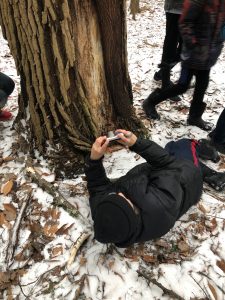
Twice a year, grades six, seven, and eight join together for an intensive week-long immersion. This winter the focus was on creating a sense of place through photography. For one week, students explored the natural and human habitats around their school, composed and edited photographs, and learned about the art of digital photography and exhibition design from experts. The immersion culminated in two curated exhibits, one at Village Wine and Coffee and another in the foyer at the Lake Champlain Waldorf School. For students who have grappled with a new subject, experimented, and acquired new skills—seeing their artwork on display builds a sense of themselves.

Our Photography Immersion Goals
Our goals for the middle school photography immersion were to:
- • Foster a sense of appreciation for and connection to our immediate environment
- • Develop in students the ability to notice what is usually unseen, and to find beauty in it
- • Explore the connection between nature and human-made structures and artifacts
Wondering about a day-in-the-life of a middle school student during our photography immersion week? Let’s walk through our kick-off day!
Elements of a Photo: Mood, Story, and Composition
Students started off the week exploring and searching for inspiration in the acres surrounding our school in Shelburne, VT and the nearby LaPlatte Nature Sanctuary. When inspiration struck, students choose their “sit spot,” which would become the observational starting point for their nature journals. Students poured notes, sketches, and ideas into their journals. While in their sit spots, students conducted a close study of their natural surroundings to hone their observational skills, which can transform a photo into a work of art.
After their first close study, students returned to our middle school music room. They divided into mixed grade groups for an introduction to how digital cameras work. The middle school team presented a slideshow of iconic photos from the last 50 years. During this presentation, we discussed images in terms of story, mood, and composition.
In the afternoon, LCWS senior Sam Gauthier, a freelance photographer, introduced students to some of the many types of photography: portraiture, landscape, sports, architecture, fashion, astrophotography, wildlife. He showed several of his own photos, critiqued them for the group, and demonstrated editing techniques.
Finally, students spent the final hour taking photos on our campus that incorporated compelling subjects and particular elements of composition that they learned earlier in the day.
A Well-Rounded Photography Immersion

After kicking off our immersion, students rounded out the week meeting with experts at the Nature Conservancy, who talked about their work in the LaPlatte Nature Preserve. They learned about the “rule of thirds,” leading lines, and the role of shadows in photography from professional photographer Alex Pintair of Ambient Photography. Students shot more photos and critiqued them. We visited the Shelburne Museum exhibit “New England Now” for added inspiration on the natural world around us.
At the end of the week, the students prepared their best image for public display. By honing their observational skills, applying their new technical skills and knowledge of visual composition, our students are able to see a familiar place in a new way. Together, their photos reveal a sense of place.
We invite you to view our students’ artwork on display at Village Wine and Coffee and in the foyer at the Turtle Lane campus of the Lake Champlain Waldorf School during the month of February.

